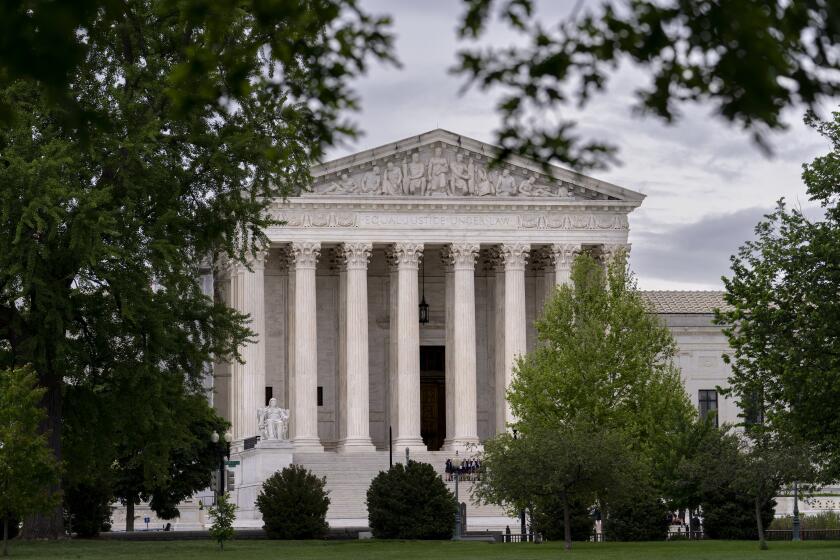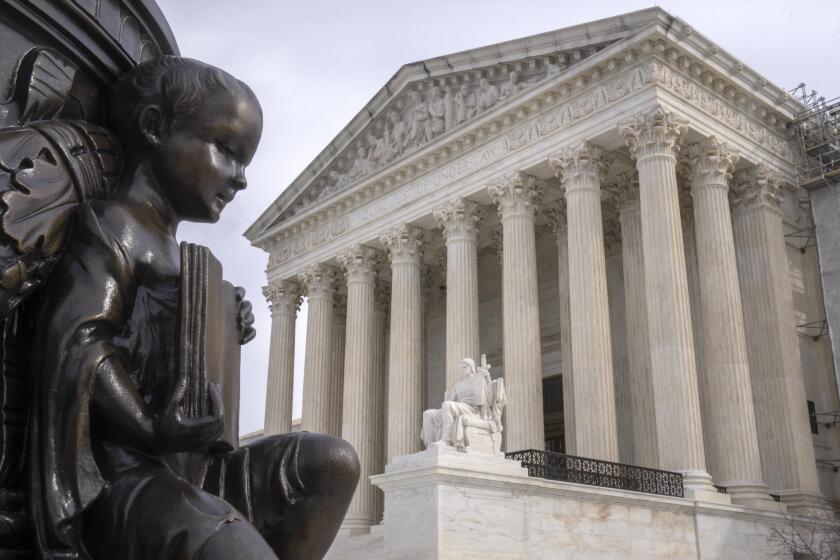A spare justice or two?
- Share via
As if President Obama did not have enough on his plate! He will soon need to nominate a Supreme Court justice to replace David H. Souter, who intends to retire. While Obama is at it -- and to make things easier next time around -- perhaps he should consider nominating a second justice now, to fill whatever vacancy might arise after Souter’s departure.
Souter’s formal letter to Obama indicates that he will step down at the end of this term -- presumably late June. But nothing prevents the president from nominating now and the Senate from confirming next month, while Souter is still a sitting justice. This would hardly be unusual. In a letter sent to President George W. Bush in July 2005, Justice Sandra Day O’Connor wrote that her resignation would become “effective on the nomination and confirmation of my successor” -- an event that did not occur until the middle of the following term. Chief Justice Warren Burger and justices Thurgood Marshall and Harry Blackmun also continued to sit during the process of nominating and confirming their successors.
But if the president may nominate a justice before a formal vacancy occurs, why can’t he do so before an informal announcement of a planned retirement? Why shouldn’t the president feel free in the next few weeks to nominate two people to the court -- an heir and a spare, one to fill Souter’s seat and one to fill the next vacancy when it arises?
Consider first the efficiency advantages. Sitting justices would be free to leave whenever they wanted, without fear that the court would be crippled until they were replaced. Likewise, an unexpected death would not leave the court short-staffed because a pre-approved replacement justice would be ready to step in -- much as vice presidents and lieutenant governors stand ready to fill executive branch positions that suddenly open up.
There was a time when Senate confirmations were quick. The Senate confirmed George Washington’s first six nominees to the court in two days. As late as 1975, Justice John Paul Stevens was confirmed less than three weeks after his nomination. But those days are gone. Since Robert Bork’s failed nomination in 1987, the Senate has typically taken months to confirm even uncontroversial court nominees. Most recently, seven months elapsed between O’Connor’s conditional resignation letter and the filling of her seat by Samuel A. Alito Jr.
Consider next the political and policy advantages. A president might entice a justice to retire by naming a replacement the justice has special reason to respect. For example, Justice Antonin Scalia is 73 years old, but no one expects that he will voluntarily resign any time soon and thereby give a liberal president carte blanche to appoint a replacement. But if Obama and the Senate moved first and named a true moderate of extraordinary distinction, Scalia would face a very different calculus. The president could move the court in his desired direction, but Scalia could have some confidence that it would not move too far
As this example illustrates, the president could choose to nominate either a general purpose vice justice, who would fill whatever vacancy might arise, or a seat-specific vice justice, who would be eligible only to fill, say, the seat currently held by Scalia when that seat becomes vacant.
If two nominees this season are OK, why not nine or 19? What is to stop an administration from stealing from future administrations by trying to fill seats that will open up only in the distant future? The Constitution’s formal rules offer rock-solid protections for future presidents. Even a nominee who has been confirmed by the Senate cannot take office until a vacancy actually exists; and the sitting president at the time that vacancy arises has the lawful authority to decline to commission even someone already nominated by his predecessor and confirmed by the Senate. Thus, even if Obama were to try to name nine vice justices, the next president would decide for himself or herself whether to honor the Obama slate or start afresh.
Indeed, even Obama would not be legally bound to commission someone whom he himself had nominated years earlier; but as a practical matter it would be very hard, politically, for him to renege, especially if a sitting justice had chosen to step down as a result. (Similarly, a president is free to veto a bill he has pledged to sign, but one who does so pays a heavy price for the double-cross.)
The idea of anticipatory vice justices may strike many observers as a big change of the rules -- albeit a change justified by the recent slowing of the Senate confirmation process. Perhaps the vice justice system should not go into effect until after the next presidential election. During that election, candidates can speak to the voters about their competing visions for the court, and any candidate who endorsed the vice justice system would have a genuine mandate to try it. For now at least, perhaps Obama needs to add only one new item to his plate, even though the Constitution gives him the option to do even more.
More to Read
Get the L.A. Times Politics newsletter
Deeply reported insights into legislation, politics and policy from Sacramento, Washington and beyond. In your inbox twice per week.
You may occasionally receive promotional content from the Los Angeles Times.










